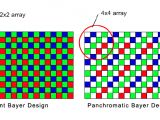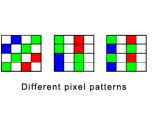Since the beginning of digital photography, manufacturers have tried to improve sensors so as to capture more detail at high sensitivities. Kodak claim that they've succeeded in changing the original Bayer design, invented in 1976 by the famous Kodak researcher Dr. Bryce Bayer, resulting in sensitivities two times or even four times higher.
According to a Kodak press release, the new proprietary technology adds panchromatic, or "clear" pixels to the red, green, and blue elements that form the image sensor array. Since these pixels are sensitive to all wavelengths of visible light, they collect a significantly higher proportion of the light striking the sensor.
The new pixel arrangements are paired with advanced software algorithms from Kodak that are optimized for these new patterns, thus improving performance when taking pictures under low light. The company behind the first affordable camera (the Brownie) also touts its new technology as allowing faster shutter speeds.
Related to theses patterns, Kodak's "A thousand nerds" blog provides more details on architectures and image processing.
"[...] we've developed several patterns, allowing us to adapt this approach to different sensor architectures and applications. For example, different patterns might have different levels of image processing associated with them - you might use a pattern with lower image processing requirements in an application where you don't have access to as powerful a processor as you might need for a different pattern," says John Compton, a Kodak engineer.
"This represents a new generation of image sensor technology and addresses one of the great challenges facing our industry - how to capture crisp, clear digital images in a poorly lit environment," said Chris McNiffe, General Manager of Kodak's Image Sensor Solutions group.
There is one problem with the new design, namely the color resolution, because the more pan pixels the sensor has the less color information it will gather. Because of this, Kodak will use different ratios of pan pixels to RGB pixels to accommodate a wide array of applications.
The new panchromatic technology is suitable for both CMOS and CCD sensors, but the first products benefiting from it will only be available in 2008.
We are just a few, but there are many of you, Softpedia users, out there. That's why we thought it would be a good idea to create an email address for you to help us a little in finding gadgets we missed. Interesting links are bound to be posted with recognition going mainly to those who submit. The address is  .
.

 14 DAY TRIAL //
14 DAY TRIAL // 

